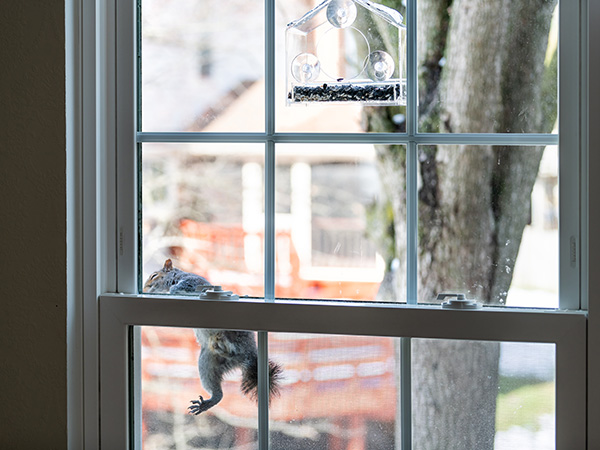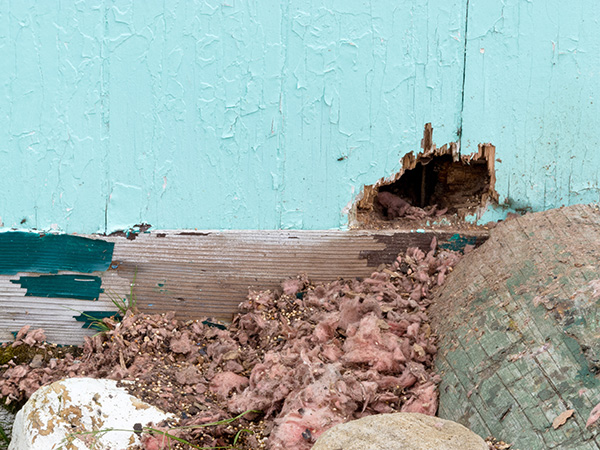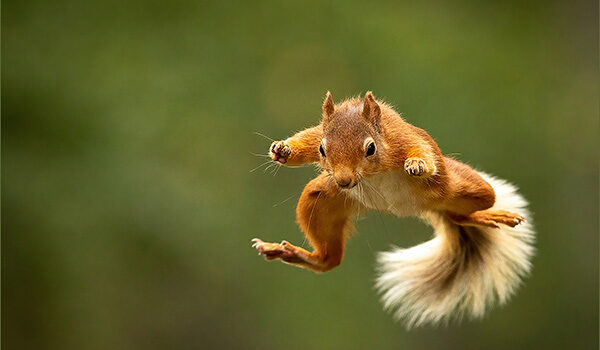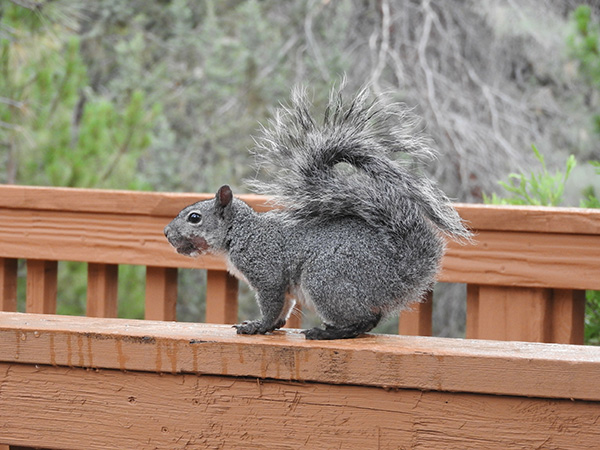
Squirrel Removal
Humane Squirrel Removal and Exclusion Services – Expert Squirrel Control
Effective Gray Squirrel Removal and Squirrel-Proofing Solutions
At Rid-A-Critter, we understand that gray squirrels can make themselves unwanted guests in your home, particularly in the attic, where they can cause a range of problems. Our expert squirrel trapping methods ensure the efficient removal of these wildlife nuisances, offering peace of mind and a quiet home environment. When it comes to gray squirrel removal, it’s not just about setting a squirrel trap and hoping for the best – we recommend a strategic approach that combines thorough wildlife control services with preventative measures.
Squirrels can be persistently invasive animals, and repeated removal efforts might be necessary to control the situation entirely. We don’t just stop at wildlife removal. We also provide comprehensive control solutions that future-proof your home against further intrusion.
Our animal control services involve a meticulous inspection to locate every possible entry point that squirrels or any critters might exploit to make their way into your house. From there, we trap the squirrels using a humane squirrel trap and seal entry points with robust materials designed to withstand gnawing by rodents and wildlife alike.
Rodents like squirrels can leave behind squirrel droppings, which pose a health risk. Our complete control services include cleaning and sanitizing the affected areas in the attic or any other parts of your home. Our team of wildlife control specialists takes a holistic approach to squirrel control, ensuring that after the removal process, your home remains rodent-free. Whether gray squirrels have made their home in your attic or found their way into roofs and gutter systems, our job is to ensure they are safely and professionally removed.
At Rid-A-Critter, we believe in doing the job once and doing it right, which is why we prioritize providing top-tier services each time we’re contacted. Homeowners seeking reliable squirrel removal need to look no further. Our recommendations for effective control include detailed follow-up to detect any new attempts at entry by squirrels or other animals, safeguarding your home against future wildlife challenges. Don’t wait for the squirrels to settle in—take proactive steps by contacting an animal control company that can handle the job with proficiency.

Squirrel-proofing your home is essential to ensure that once animals are removed, they don’t return. Our control services are designed to help your house resist future invasions of gray squirrels and other wildlife. Trapping squirrels is just the first step. The real work begins in ensuring your home stays free of these furry critters. We take the time to carefully assess your home’s vulnerabilities and apply proven squirrel-proofing methods to every potential entry point – from the attic to the basement.
If gray squirrels are making themselves at home in your house, it’s time to contact Rid-A-Critter for professional removal and control services. We approach every job with the dedication and expertise necessary to make your home safe again. Don’t let squirrels turn your attic into their playground. Reach out to us, and we’ll take every measure to trap and remove them, ensuring your peace and comfort. With Rid-A-Critter on the job, you can count on a squirrel-free home fortified against future wildlife intrusions.
Identifying Signs of Flying Squirrel and Gray Squirrel Infestations
When it comes to wildlife in your attic, few culprits are as mischievous and persistent as squirrels. Understanding the threat posed by both flying and gray squirrels is fundamental to ensuring your home remains a sanctuary. Flying squirrels, with their nocturnal habits and gliding prowess, as well as gray squirrels, known for their agility and adaptability, can cause significant damage and introduce diseases into your living space. Distinguishing between these critters is essential for appropriate squirrel removal.
Among the first indicators of an infestation are the sounds of scampering and scratching coming from the attic. Flying squirrels, being social creatures, often invite a party of wildlife into your home in the dead of night. In contrast, the gray squirrel is a diurnal visitor, making its presence known with daylight disruptions. Should you hear the pitter-patter of tiny feet, consider baby squirrels might be nested nearby. To confirm suspicions, inspecting for squirrel droppings can provide concrete evidence, as these are distinct to those aware of their telltale shape and size.
Detecting the source of these problems often leads to areas where damage is abundant. Squirrels, especially the eastern gray species, are notorious for gnawing on wood to maintain their ever-growing incisors. This behavior can lead to compromised structures and exposed wires, increasing the risk of additional damage. The gray squirrel and its flying cousin find entrances to your attic by exploiting vulnerabilities in the roofing or siding, emphasizing the importance of comprehensive squirrel-proofing solutions.
When considering the best approach for squirrel trapping, it’s imperative to consider the unique behaviors of each species. For flying squirrel removal, a specific type of squirrel trap that accommodates their gliding nature may be required. Meanwhile, the gray squirrel may fall victim to a more traditional squirrel trap. With our professional squirrel removal services, Rid-A-Critter ensures traps are humanely and effectively placed, mitigating the potential for harm to the squirrel or unnecessary stress to the home’s inhabitants.
It’s important to note the potential health risks associated with squirrels. The diseases they can carry, such as rabies or parasites, pose serious concerns for both people and pets. Comprehensive animal control must also account for these health implications, assuring that removal tactics also prioritize the well-being of all involved.

Rid-A-Critter’s removal solutions are designed to address the issues squirrels bring to your home. Our wildlife experts have extensive experience dealing with invaders that make their way onto the ground and then into your attic. We understand the range of problems that both flying and gray squirrels can introduce, from their constant chewing on wood, which undermines structural integrity, to their potential as vectors for diseases. Our squirrel removal services cater to every facet of the infestation, ensuring your home remains a sanctuary for the people within it, not the wildlife around it.
Identifying the signs of flying squirrel and gray squirrel infestations is crucial in protecting your home from damage and diseases. At Rid-A-Critter, we don’t just remove squirrels — we prevent their return, securing the home. Trust us to restore the peace and security of your attic and ensure your home remains safe and comfortable for you and your family.
Professional Squirrel Trapping and Exclusion Techniques for Ground Squirrels
When it comes to the challenge of managing pesky ground squirrels, Rid-A-Critter’s professional squirrel removal services stand out in the field of wildlife control. Our team of experts is adept at both flying squirrel and the more common squirrel trapping, ensuring that your property is free from the havoc these critters can wreak. Ground squirrels, in particular, can cause significant damage to your yard, gnawing on plants and burrowing in ways that undermine the integrity of your space.
Flying squirrels might seem like an adorable novelty, but the combined damages can be extensive when they take up residence alongside their ground-based counterparts. From compromised trees to structural vulnerabilities, squirrels are more than just a nuisance – they’re a threat to the safety of your home. Understanding the behavior of these wildlife pests is the first step in effective control, and our team is trained to do just that.
Baby squirrels, for instance, can squeeze into tiny openings, making them adept invaders of attics and eaves. Rid-A-Critter’s comprehensive squirrel-proofing solutions are designed to address these types of problems, preventing recurrence and ensuring that your home remains secure from further intrusion. But why is prompt removal and control of squirrels vital? These critters are known carriers of diseases that pose risks to humans, making it essential to tackle infestations head-on.

Using the latest squirrel trap technology, our experts provide solutions tailored to the specific needs of your property. Each squirrel trapping job is conducted with respect for the animals and the goal of reestablishing harmony in your environment. Traps are not the only tool in our arsenal. We employ a variety of techniques to remove squirrels, ensuring every possible way these animals might access your home is blocked with robust exclusion practices.
As your dedicated animal control specialists, Rid-A-Critter understands that problems with wildlife like squirrels require a humane and considerate approach. We’re in the business of solving problems, not just for property owners but also in a way that respects the creatures we’re dealing with. The presence of these bushy-tailed guests, whether baby squirrels or fully grown, is a sign of some imbalance, and we’re here to restore order.
Our team’s proactive measures don’t just stop at removal and exclusion. We also work to educate the people we help on the importance of food control and property maintenance to deter squirrels from returning. We know that wildlife, including squirrels, bats, rats and other critters, have their place in nature, but when they clash with humans, steps need to be taken to protect both parties.
An efficiently executed squirrel trapping job lays the groundwork for a pest-free property, allowing you to enjoy your home without unwelcome disturbances.
How Our Squirrel Removal Services Work
Our squirrel control services are designed to address and resolve your wildlife concerns efficiently. Here’s a step-by-step look at how we ensure your home becomes and remains squirrel-free:
- Initial inspection: Our team starts by thoroughly inspecting your property to identify signs of squirrel presence and locate potential entry points. This helps us understand the extent of the infestation and plan an effective removal strategy.
- Humane squirrel trapping: We use humane and eco-friendly traps to capture the squirrels without harming them. Each trap is strategically placed where there’s the most squirrel activity.
- Safe squirrel removal and exclusion: Once a squirrel is trapped, our team will safely remove it from your property and seal all identified entry points with high-quality materials to prevent future invasions. This includes sealing cracks, crevices and any openings in the roof, walls or foundation.
- Damage repair and cleanup: We repair any damage caused by the squirrels, including insulation and structural damage. We also clean and sanitize the areas contaminated by squirrels to prevent health risks.
- Prevention and follow-up inspection: To prevent future infestations, we offer advice on landscaping and home maintenance practices that discourage squirrels from returning.
Following these steps, we deliver a comprehensive squirrel removal service that eliminates the immediate problem and prevents future issues.

Choose Rid-A-Critter — Your Trusted Squirrel Removal Company
Rid-A-Critter offers the most effective and humane solution to your squirrel problems. Here are the key benefits that set us apart and make us the preferred choice for homeowners, schools and churches across Georgia and Alabama:
- Humane removal methods: We understand the importance of wildlife. Our methods prioritize the humane treatment of animals throughout the removal process.
- Experienced professionals: Our team comprises experienced wildlife control specialists who understand squirrel behavior and effective removal techniques.
- Comprehensive services: We address all aspects of squirrel control, from initial inspection to final repairs and cleanup.
- Eco-conscious practices: We use safe methods and materials for the environment, your family and the animals we remove.
- Long-term solutions: Our exclusion methods are designed to prevent future infestations, offering lasting peace of mind.
- Expertise with all squirrel species: Our team is experienced in handling ground, gray and flying squirrels, ensuring effective removal of all types.
- Local experience: We are familiar with local wildlife habits in Alabama and Georgia. We offer tailored solutions that address specific challenges.
- Comprehensive warranties: We stand behind our work by offering warranties on our services.
- A+ BBB rating: Our consistently high ratings reflect our commitment to customer satisfaction and quality service.
Request a Quote for Effective and Humane Squirrel Removal Services
For more information about squirrels, or our squirrel control services, check out our YouTube channel:
Whether you’re grappling with flying squirrels taking over the attic or ground squirrels turning your walls into their personal playground, remember that Rid-A-Critter is here to assist. Our focus is not merely on squirrel removal but on a comprehensive, sustainable approach to wildlife control that secures your sanctuary from invaders.
Trust Rid-A-Critter to handle your squirrel problems with the skill, care and efficiency that come from years of experience in animal control. Step up your home’s defense against wildlife damages and diseases with Rid-A-Critter’s expert services. Contact us today to get a free quote.
Note: Our prices include all services listed in our removal services. All squirrel removal services include exclusion work as well.
